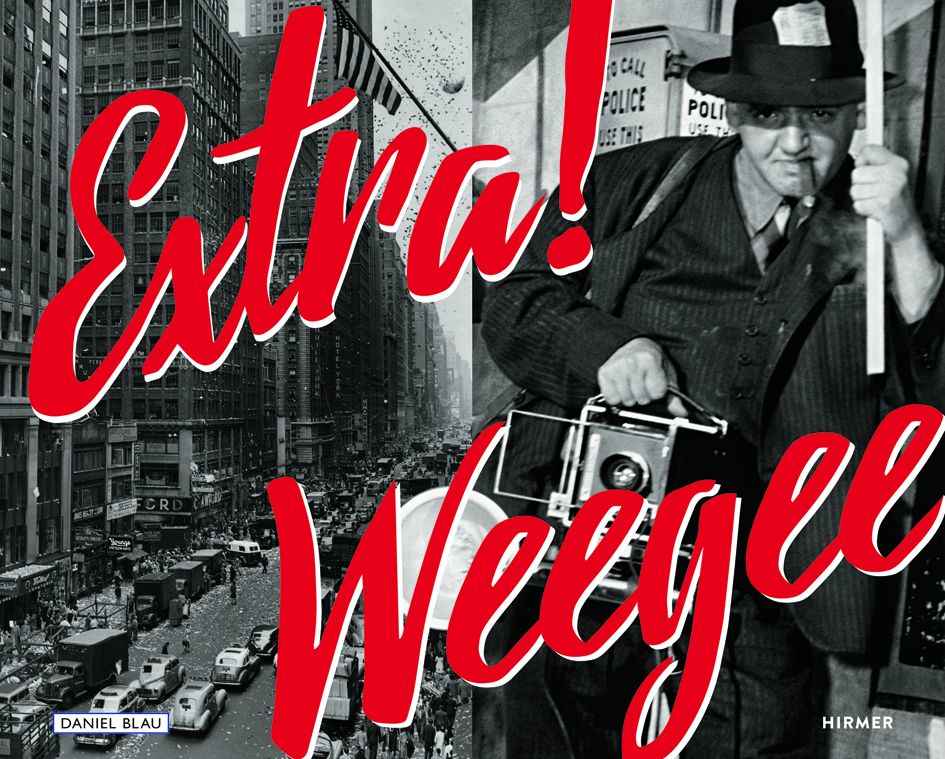
A collection of 359 vintage photographs from 1929-1946
The Hirmer book Extra! Weegee contains A Collection of 359 Vintage Photographs from 1929-1946, edited by Daniel Blau (Amazon.com, Amazon.co.uk, Amazon.fr, Amazon.de). Ryan Adams states that Weegee left Acme in 1935, frustrated for never having received credit for his published work. He stayed in New York until 1947, working as a freelance photographer who, in 1938, was given permission to install a police radio in his car. Subsequently, he moved to Hollywood to (unsuccessfully) pursue an acting career until his return to New York City in 1952.
The photographs and stories presented in Extra! Weegee originate from the Newspaper Enterprise Association (N.E.A.) archive, the parent company of Acme Newspictures. Ryan Adams writes that the N.E.A. was founded in 1902 by Edward Willis Scripps and was the first of its kind. As a syndicate, it focused on national events, feature stories, cartoons and illustrations. In the 1920s, wanting to include photography, N.E.A. created Acme Newspictures to serve as its primary news photo service. While Acme operated separately from N.E.A.’s syndication service, N.E.A. actively maintained a central photographic archive for all of Acme’s bureau’s, thus creating one of the largest archives in the United States.
In the early 1950s, N.E.A. sold Acme to the United Press Association, founded in 1907 by the same Edward Willis Scripps. In 1958, United Press became the United Press International (UPI), after a merger with the International News Service.
Ryan Adams underlines that the physical N.E.A. photo archive never left Cleveland after UPI’s founding in 1958. The archive remained undisturbed for over 20 years until Don Kirschnick rediscovered and bought it but — due to financial troubles — was forced to sell it in 1994 after a minor part had already been sold earlier. In late 2012, the photojournalist expert Ryan Adams rediscovered it in a Midwest storage facility where it had been housed since its 1994 purchase.
Extra! Weegee with vintage Weegee prints from the once lost archive is not the first collaboration between Ryan Adams and Daniel Blau. In 2015, they exhibited works by Margaret Bourke-White and, recently, war photographs in the museum show Robert Capa — Kriegsfotografien 1943-1945 at the Kupferstichkabinett Dresden in the Residenzschloss where you can find the world famous Green Vault (Grünes Gewölbe).
The front cover of Extra! Weegee shows on the left a detail of the photograph New York Celebrates Italy’s Defeat from September 8, 1943 and, on the right, a detail of Weegee Lends a Helping Hand from May 29, 1945.
According to Daniel Blau, Weegee elevated press photography to an art. He was an innovator by incorporating emotions in his visually striking photographs. He defined modern photojournalism as an avenue for storytelling. He often directed his camera on onlookers rather the the action, the spectacle itself, capturing people’s reactions. Weegee allowed viewers to feel the news rather than just read it. Daniel Blau concludes that Weegee’s photographs became the headlines. He was a radical visionary who had an impact even on Hollywood films such as Naked City, Dr. Strangelove and Boardwalk Empire.
Ryan Adams explains in his 2015, one-page contribution to the book Extra! Weegee that the famous photographer navigated the labyrinth of New York’s streets, documenting its untold life from the grandiose hall of the Metropolitan Opera House to the unsophisticated sanctuary of Sammy’s Bar, the congregation of inquisitive spectators to the abrupt silence of a gangland murder.
Extra! Weegee is above all a photo book with only a few short texts not longer than nine pages altogether. The photographs speak for themselves. They are arranged according to subjects such as crash, crowds, fire, dead, crime, fest, friends, strikes and characters.
In his book contribution, Sydney Picasso let’s Weegee describe his work in his own words, citing one of his autobiographical books: “For over ten years I made a lush living covering murders from Manhattan Police Headquarters. I was on the job twenty-four hours a day seven days a week, including Sundays and legal and bank holidays. No eight-hour day for Murder, Inc., no punching time clocks, no two-week vacation!”
Weegee used early on a credit stamp which imprinted: “Weegee: The Famous”. This was before he actually rose to fame. Sydnee Picasso notes: “Weegee was a perpetrator of <noise>, the predecessor of <chatter>. The translator and the interpreter of the walkie-talkie, the radio and the wire transmission, walked right into the ring, the heavyweight whose force is still resounding.”
Last, but not least, Weegee was born Usher Fellig near Lemberg/Lviv.

Extra! Weegee: A Collection of 359 Vintage Photographs from 1929-1946, edited by Daniel Blau. Hardcover, Hirmer, 2017, 336 pages with 361 illustrations. Order the book from Amazon.com, Amazon.co.uk, Amazon.fr, Amazon.de.
Article added on August 1, 2017 at 07:36 Swiss time